7.2: Generating Electricity
- Page ID
- 85513
- Know the basic governmental agencies that have and now regulate the United State's nuclear facilities and materials.
- Understand the basics of how electrical energy is produced and transmitted.
- Learn the purpose of transformers and substations in electrical energy.
- Calculate the cost of running an appliance for a period of time (typically for a month).
- Have knowledge of "vampire" devices.
AEC/NRC History
During the Manhattan Project, Enrico Fermi and Leo Szliard constructed the world's first nuclear reactor in the basement of the University of Chicago. It consisted of layers of graphite (carbon) embedded with pieces of uranium. The sustained chain reaction was measured via a Geiger counter. After World War II, Manhattan Project scientists knew that fission could be used for power as well. In 1946, Harry S. Truman signed the McMahon/Atomic Energy Act. This transferred atomic energy control from the military to civilian power. The Atomic Energy Commission (AEC) was established to develop nuclear energy for peaceful purposes. This group would study how fission could be used to power homes, industries, submarines, and battleships. In addition, the AEC would investigate how nuclear isotopes could be used in the fields of medicine and agriculture.
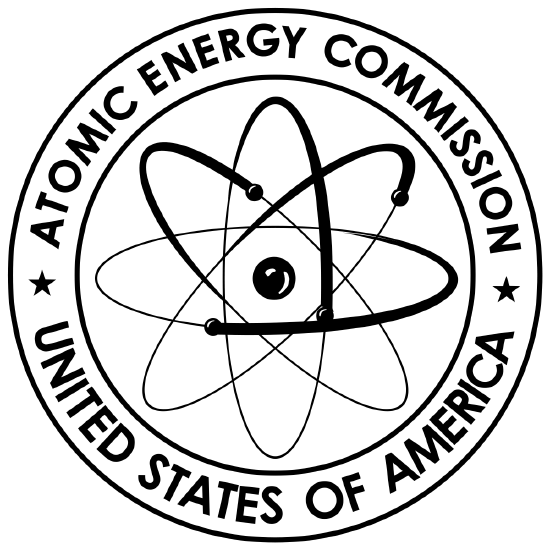
The AEC constructed the first experimental breeder nuclear {this type of equipment uses LEU (majority of mass would be U-238) to produce weapons- grade plutonium} reactor in Arco, Idaho. On December 20, 1951, the reactor went online and produced enough energy to power four light bulbs. In 1957, the first full-scale American commercial nuclear reactor was completed in Shippingport, Pennsylvania. Unit One reactor was operated by Duquesne Light Company and cost approximately 73 million dollars. The electrical power this reactor produced varied from 60 to 100 MW. Over its twenty-five year lifetime, this reactor produced over 7.4 billion kilowatt hours of energy. In 1989, Shippingport Reactor 1 was shut down and decommissioned due to the cost of running and maintaining this aged reactor.
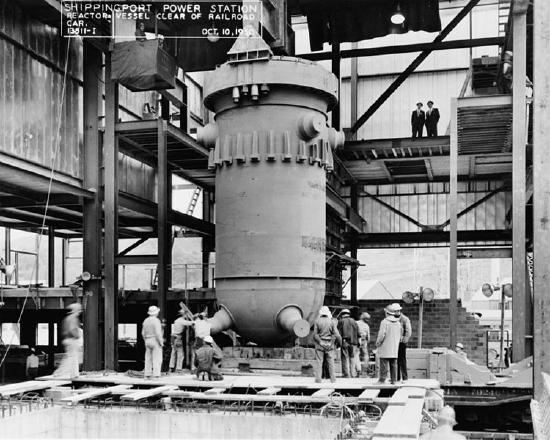
From its conception, the AEC appeared to take a greater interest in nuclear weapons security than nuclear reactor safety. For this reason, Congress dismantled the AEC in 1974. The existing Department of Energy (DOE) would focus on nuclear security (weapons and materials) and nonproliferation (stopping the construction of nuclear weapons). The newly formed Nuclear Regulatory Commission (NRC) would concentrate on ensuring the safe use of radioactive materials. In other words, radioisotopes used in medical, agricultural, and industrial applications would be watched to minimize the contamination of people and the environment. Additionally, NRC would regulate all commercial reactors. These energy sources would be licensed and inspected for safety purposes. If a reactor failed inspection, then the NRC has the power to enforce fines and penalties on that particular reactor.
What is Electricity?
Electricity is a form of energy resulting from the flow of electrons. When magnetic fields are applied to a wire containing electrons, a continuous current (rate of electron flow) is produced. This type of current is a direct current (DC) and can be used to power battery supplies. Direct currents are not capable of transmitting electricity long distances. Electrons in a direct current encounter significant resistance which limits the flow of energy. A high current corresponds with a large loss of electrical energy transfer or otherwise known as electrical power. When keeping electrical power constant, current and voltage (pressure that pushes electrical current) are inversely related. Thus, it is optimal to run an electrical grid at a high voltage.
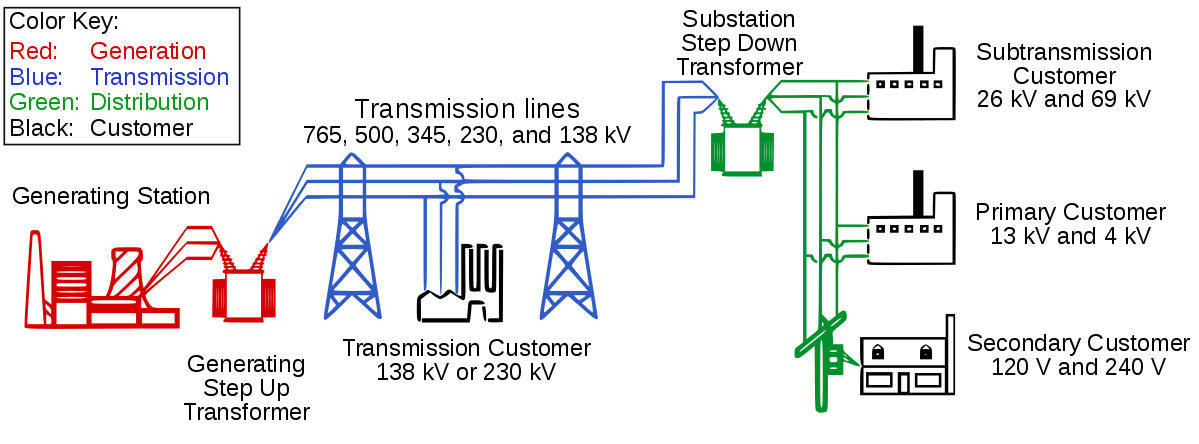
To make electricity transmission more efficient, alternating currents are utilized. Here, the electrons fluctuate in various directions. A transformer increases the voltage to decrease the current. Again, this step is needed to reduce energy loss and optimize power. When the electricity is transmitted to the customer, then a substation reduces the voltage for safety and economical reasons.
General Energy Production
The great majority of all electrical generating systems (whether coal-burning power plants, hydroelectric plants, or nuclear power plants) all follow a reasonably simple design. The electricity is produced by spinning a coil of wire inside a magnetic field. When a fluid (air, steam, water) is forced through the pipe, it spins the fan blades which in turn spin the axle. To generate electricity, the axle of a turbine is attached to the loop of wire in a generator. When a fluid is forced through the turbine, the fan blades turn, the turbine axle turns, and the loop of wire inside the generator turns, thus producing electricity.
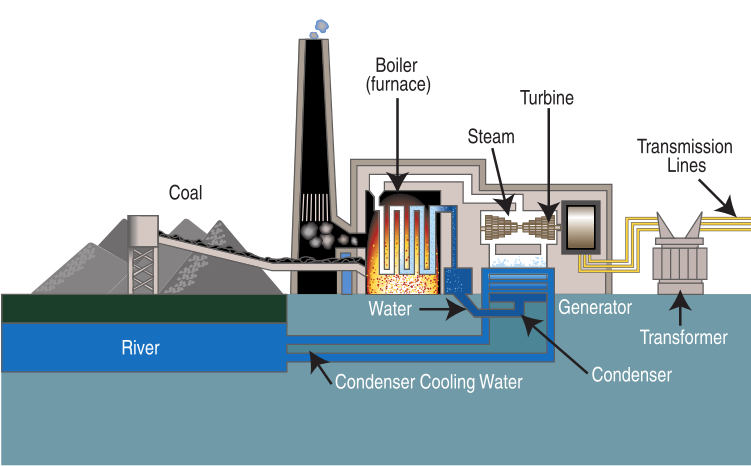
The essential difference in various kinds of electrical generating systems is the method used to spin the turbine. For a wind generator, the turbine is a windmill. In a geothermal generator, steam from a geyser is forced through the turbine. In hydroelectric generating plants, water falling over a dam passes through the turbine and spins it. In fossil fuel (coal, oil, natural gas) generating plants, the fossil fuel is burned and the heat is used to boil water into steam and then the steam passes through the turbine and makes it spin. In a fission reactor generating plant, a fission reaction is used to boil the water into steam and the steam passes through the turbine to make it spin.
Basic Energy Units
When understanding electrical energy consumption, the kilowatt (kW) is the most commonly used unit in the United States. This unit is a measure of power. A more specific unit, the kilowatt-hour (kWh) is utilized to denote how much fuel is used to generate electrical energy over a specific amount of time. Power meters are installed in consumer and industrial facilities to measure kilowatt-hour usage. Power companies charge various rates around the country for electrical consumption. The pictures below show a traditional power meter and a typical residential power bill. Watch this video to get an understanding of the kilowatt-hour and how different appliances use different amounts of kilowatts.
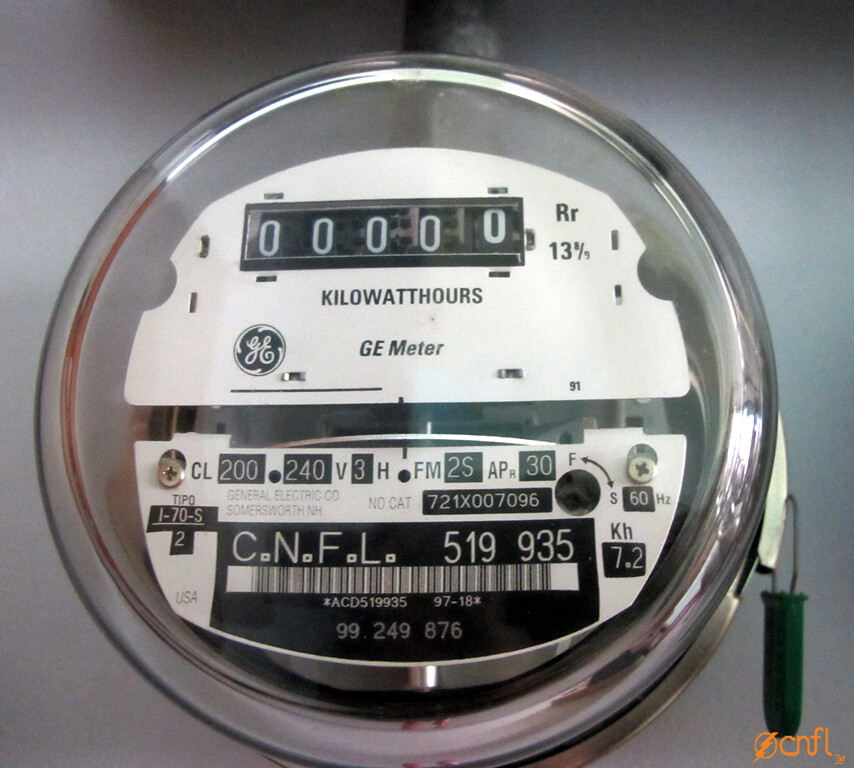
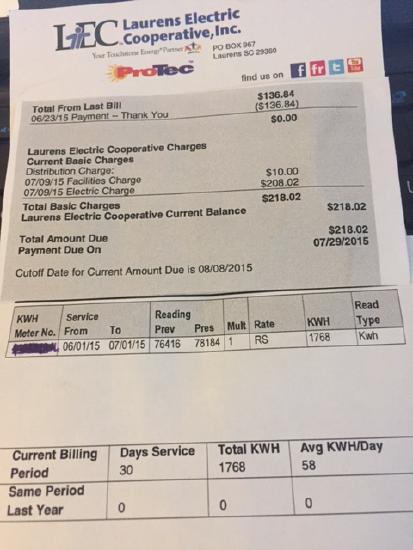
Wattages for common household appliances can be obtained by looking at labels or using the manufacturer's website. Typically, power units for these devices are listed in watts. Calculating a price for the monthly use can be done by following the rules listed in the text box. Be aware of "vampire" devices. Even when these items are turned off, they still drain energy from your home. Conserve energy by unplugging these apparatuses. Examples of these include desktop computers/displays, faxes, printers, TVs, microwaves, garage door openers, video game consoles, coffee makers, electric toothbrushes, cable boxes, and device charges. If a consumer is unwilling to unplug these devices, then they should invest in power cords with surge protection. Turning off power strips after use will allow the consumer to still conserve energy.
When purchasing appliances for the home or business, be sure to note the wattage of each product. Energy-efficient devices will save money a consumer money on their monthly electric bill.
To calculate the monthly electrical bill for an appliance, use the following steps listed below:
- Locate the running wattage on a given appliance. For a running wattage, convert this value to kilowatts using dimensional analysis (recall 1000 watts = 1 kW)
- Multiply the calculated kW by the hours of operation for a month.
- Research the energy value your power company charges per month (Furman U uses Duke Energy and current values can be located using this link. The December value for the first 1000 Kw use is 11.8¢ per kilowatt hour. If you exceed 1000 Kw for your home, you will pay a higher rate for the extra power.
- Multiply the kWh by the monthly rate. The final answer will be a cent value. Divide this number by 100 to obtain the dollar amount.
Sources
Paul Flowers (University of North Carolina - Pembroke), Klaus Theopold (University of Delaware) and Richard Langley (Stephen F. Austin State University) with contributing authors. Textbook content produced by OpenStax College is licensed under a Creative Commons Attribution License 4.0 license. Download for free at http://cnx.org/contents/85abf193-2bd...a7ac8df6@9.110).


